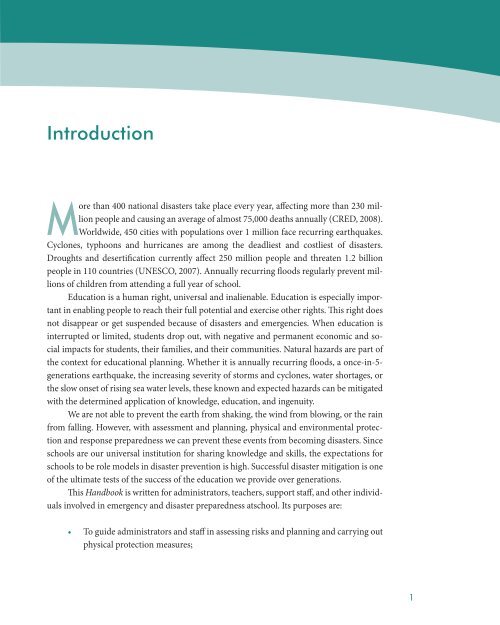Disaster and Emergency Preparedness: Guidance for ... - INEE Toolkit
Disaster and Emergency Preparedness: Guidance for ... - INEE Toolkit
Disaster and Emergency Preparedness: Guidance for ... - INEE Toolkit
You also want an ePaper? Increase the reach of your titles
YUMPU automatically turns print PDFs into web optimized ePapers that Google loves.
IntroductionMore than 400 national disasters take place every year, affecting more than 230 millionpeople <strong>and</strong> causing an average of almost 75,000 deaths annually (CRED, 2008).Worldwide, 450 cities with populations over 1 million face recurring earthquakes.Cyclones, typhoons <strong>and</strong> hurricanes are among the deadliest <strong>and</strong> costliest of disasters.Droughts <strong>and</strong> desertification currently affect 250 million people <strong>and</strong> threaten 1.2 billionpeople in 110 countries (UNESCO, 2007). Annually recurring floods regularly prevent millionsof children from attending a full year of school.Education is a human right, universal <strong>and</strong> inalienable. Education is especially importantin enabling people to reach their full potential <strong>and</strong> exercise other rights. This right doesnot disappear or get suspended because of disasters <strong>and</strong> emergencies. When education isinterrupted or limited, students drop out, with negative <strong>and</strong> permanent economic <strong>and</strong> socialimpacts <strong>for</strong> students, their families, <strong>and</strong> their communities. Natural hazards are part ofthe context <strong>for</strong> educational planning. Whether it is annually recurring floods, a once-in-5-generations earthquake, the increasing severity of storms <strong>and</strong> cyclones, water shortages, orthe slow onset of rising sea water levels, these known <strong>and</strong> expected hazards can be mitigatedwith the determined application of knowledge, education, <strong>and</strong> ingenuity.We are not able to prevent the earth from shaking, the wind from blowing, or the rainfrom falling. However, with assessment <strong>and</strong> planning, physical <strong>and</strong> environmental protection<strong>and</strong> response preparedness we can prevent these events from becoming disasters. Sinceschools are our universal institution <strong>for</strong> sharing knowledge <strong>and</strong> skills, the expectations <strong>for</strong>schools to be role models in disaster prevention is high. Successful disaster mitigation is oneof the ultimate tests of the success of the education we provide over generations.This H<strong>and</strong>book is written <strong>for</strong> administrators, teachers, support staff, <strong>and</strong> other individualsinvolved in emergency <strong>and</strong> disaster preparedness atschool. Its purposes are:To guide administrators <strong>and</strong> staff in assessing risks <strong>and</strong> planning <strong>and</strong> carrying outphysical protection measures;1
















